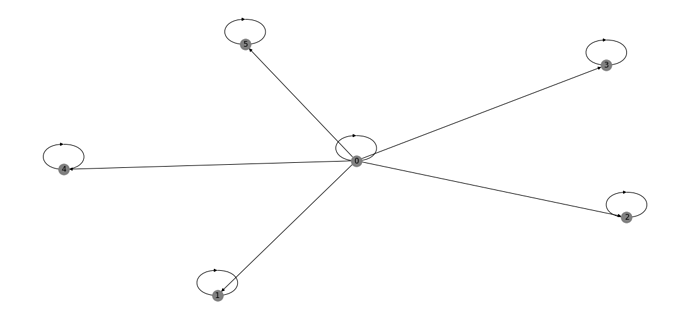Hello All. I am new in the graph and would appreciate if anyone could help.
I want to classify graph nodes as odd or even based on the feature value of each node. the features are randomly integer numbers between 1 to 100.
the base graph is like this
base_graph = dgl.graph(([0, 0, 0, 0, 0], [1, 2, 3, 4, 5]))
base_graph=base_graph.add_self_loop()
first I define a function that generates a batch of the same graphs and applies a random number to each node.
def generate_graphs(num_):
list_g=[]
list_label=[]
list_rnd=[]
for _ in range(num_):
g=copy.deepcopy(base_graph)
rnd_num=torch.randint(0,1000,(1,))
g.ndata['x']=torch.ones(6, 1)*rnd_num
list_g.append(g)
list_label.append(torch.tensor(int((rnd_num*6)%4)))
list_rnd.append(rnd_num)
return list_g,list_label,list_rnd
I also used a simple model:
class GCN(nn.Module):
def __init__(self, in_feats, h_feats, num_classes):
super(GCN, self).__init__()
self.conv1 = dgl.nn.pytorch.GraphConv(in_feats, h_feats)
self.conv2 = dgl.nn.pytorch.GraphConv(h_feats, num_classes)
def forward(self, g, in_feat):
h = self.conv1(g, in_feat)
h = torch.relu(h)
h = self.conv2(g, h)
return h
and trained like this.
model=GCN(1,16,2)
optimizer = torch.optim.Adam(model.parameters(), lr=0.01)
loss_fn = nn.CrossEntropyLoss()
for epoch in range(1000):
model.train()
list_g,list_label,_=generate_graphs(64)
# pdb.set_trace()
g=dgl.batch(list_g)
node_features=g.ndata['x']
logits = model(g, node_features)
# loss=nn.functional.cross_entropy(logits,torch.tensor(list_label).long())
loss=F.nll_loss(F.log_softmax(logits,1),list_label)
optimizer.zero_grad()
loss.backward()
optimizer.step()
if epoch%100==0:
print('Epoch %d | Loss: %.4f' % (epoch, loss.item()))
but the model is not learning at all.

